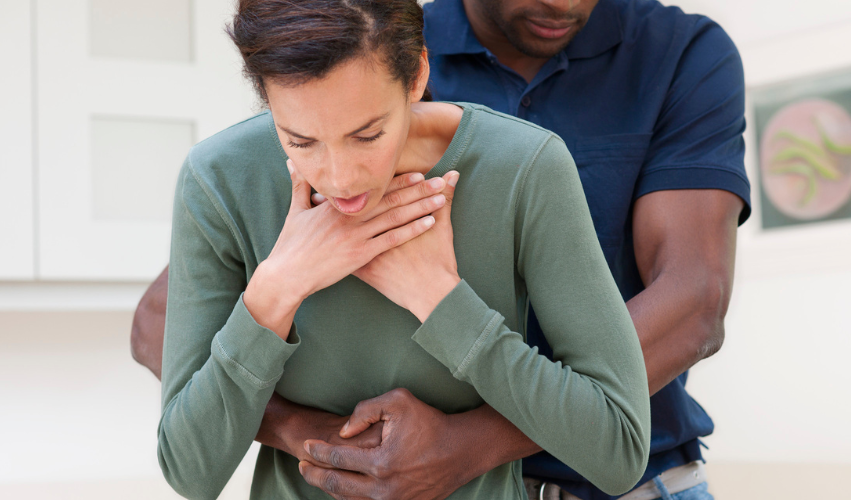
What to do in the seconds following a medical emergency
Date: Tuesday, 19 November 2024. -
Blog, First Aid, First Aid Emergencies
It is something that everyone hopes will never happen, but medical emergencies do happen - and responding confidently and quickly in these situations is vital for the best possible outcomes.
From allergic reactions and choking to heart attacks and cardiac arrest, certain emergencies require immediate intervention to prevent death. In this blog we will look at a few common medical emergencies and how to respond in the initial moments for the best chance of a good outcome.
Choking
A blockage in the airway due to food or a foreign object can be a terrifying and dangerous experience. While more common in young children and the elderly, almost 300 people die as a result of choking every year in the UK.
Signs of choking can include grabbing frantically at the throat, making wheezing noises and turning pale or blue. Immediate action must be taken if choking is suspected.
A combination of abdominal thrusts and back blows is the guidance provided by the NHS for dealing with choking. This consists of leaning the choking person forwards and delivering five sharp blows to the centre of their back, the vibration created in the airways through the blows is often enough to dislodge the object.

If this doesn’t work, abdominal thrusts should be given: stand behind the person who is choking while wrapping hands around their waist, and pull inwards and upwards hard five times. Repeat the back blows and abdominal thrusts until emergency services arrive or the casualty falls unconscious. If the casualty becomes unconscious, begin CPR.
Allergic reaction/anaphylaxis
The most well-known symptom of anaphylaxis is swelling of the airways, which causes difficulty breathing, wheezing, coughing as well as difficulty swallowing. Immediate attention is required if these symptoms are present as the casualty will not be getting sufficient oxygen to their vital organs.
Some symptoms appear less obviously, including feeling lightheaded or faint, dizziness, nausea, vomiting, diarrhoea, abdominal pain or cramping, confusion, anxiety, heart palpitations, or collapse and unconsciousness
If someone is experiencing anaphylaxis, you should immediately call 999 and administer their autoinjector or epipen if they have one. This is injected into the outer thigh, if condition doesn’t improve they may need another injector.
If the casualty begins to breathe comfortably, they can sit and await emergency services. Remain prepared to begin CPR if the casualty falls unconscious.
Deep cuts/lacerations
Deep cuts can be a risk in workplaces where sharp places such as knives or saws are present - and they require immediate attention to prevent worsening.
Gentle pressure should be applied to the cut with a clean cloth to help stop the bleeding, if the cut is on an arm or leg, it should be raised above the heart. The wound should then be cleaned with water to remove any dirt and debris, the area around the wound can be cleaned with antiseptic.
A sterile adhesive dressing or plaster should then be used to cover the wound. If the wound is deep or doesn’t stop bleeding with pressure, medical attention should be sought.
Heart attack
A heart attack is a medical emergency where the heart muscle doesn’t receive enough blood flow due to a blockage and begins to die. The terms heart attack and cardiac arrest are often used interchangeably but are very different.
Someone who is suffering a heart attack will be conscious and breathing but typically in pain which can start in the chest and spread to the arms and jaw. If a heart attack is suspected, call 999 and keep the casualty as comfortable as possible until emergency services arrive.
If the person is not allergic to aspirin, give them 300mg to chew slowly while they wait.
Cardiac arrest
A cardiac arrest is one of the most urgent medical emergencies; the heart suddenly stops beating effectively due to an ineffective rhythm and death follows within minutes if there is no intervention.
Someone suffering a cardiac arrest will immediately fall unconscious and not be breathing normally. No oxygenated blood will be being pumped around the body and the vital organs so Cardiopulmonary Resuscitation (CPR) is required.
CPR acts as a manual pump to push blood around the body while the heart is beating, but it will not restart the heart alone. Performing CPR will buy time until an Automated External Defibrillator can be located.
An AED delivers a shock to someone in cardiac arrest in an attempt to restart an effective heart rhythm. After calling 999, the call handler should direct you to your nearest available AED which is registered on the Circuit.
Once the AED is located and switched on, it will provide audio and/or visual prompts to guide the responder through the rescue.
Survival rates for cardiac arrest can be over 70% if a defibrillator is used within 3 minutes, but can be as low as 6% if help is not given in the first few minutes.
Be confident to respond quickly
In all of the above situations, responding promptly can be the difference between life and death. Being confident in first aid skills and how to recognise an emergency makes someone much more likely to intervene and give first aid.
Imperative Training offers a range of emergency training, from general First Aid in the Workplace, to AED and CPR training.
Contact us at This email address is being protected from spambots. You need JavaScript enabled to view it., call us at 01617767420 or visit our website to learn more.
